A friend of mine eats a lot of Snickers. When he’s working in the garden, after he finishes a workout, when he’s working overtime to develop his consulting activity, … Got a Snickers bar? He’ll take it. Nobody ever needs to convince him.
“Stefan, I wish I could get my prospects to be as easily convinced about me,” he said to me as he recently devoured another one.
– “To convince them, maybe you should show them what you have to offer first,” I answered.
The difficulty here?
What a consultant like my friend has to offer to prospects are skills, knowledge and experience. Unlike with what comes out of a Snickers wrapper, there is no “taste” to get people hooked on. And even when they do use your service, there’s no way to make sure the output is always consistent.
Except, actually there is. How? By using a maturity model (and more concretely: a maturity assessment). We’ll tell you more about it in this article.
Note: Already convinced and just want to develop your very own maturity model to turn it into a full-blown maturity assessment? Then this blog article is what you’re looking for.
What is a maturity model?
A maturity model is a framework to describe the condition of a business or organization in one or more areas, through predefined criteria. The maturity level indicates how well a business or system within a business is doing.
Think of a medical check-up. Just as it’s best practice to regularly receive a full medical check-up from your doctor to maintain good health on different levels, businesses need regular check-ups to assess their condition in different areas too. Now, apart from operating, there are two things a doctor can do: describe what she or he’s identifying and prescribe how to ameliorate what she or he has identified. The same goes for consultants who apply a maturity model:
A descriptive maturity model framework
Based on a number of questions that cover relevant topics, a consultant can evaluate and describe the condition of a client. Ideally this is based on benchmark data about similar or competing companies. The assumption is that the client knows how to improve its own condition based on the evaluation. Advice from the consultant is therefore very basic or generic.
Example of a business maturity model (descriptive model)
Demand Metric has created maturity models for businesses within a number of different areas. These maturity models don’t just look at business performance as a whole but rather attempt to determine the maturity level for a specific business area, e.g. digital marketing, public relations or sales enablement.
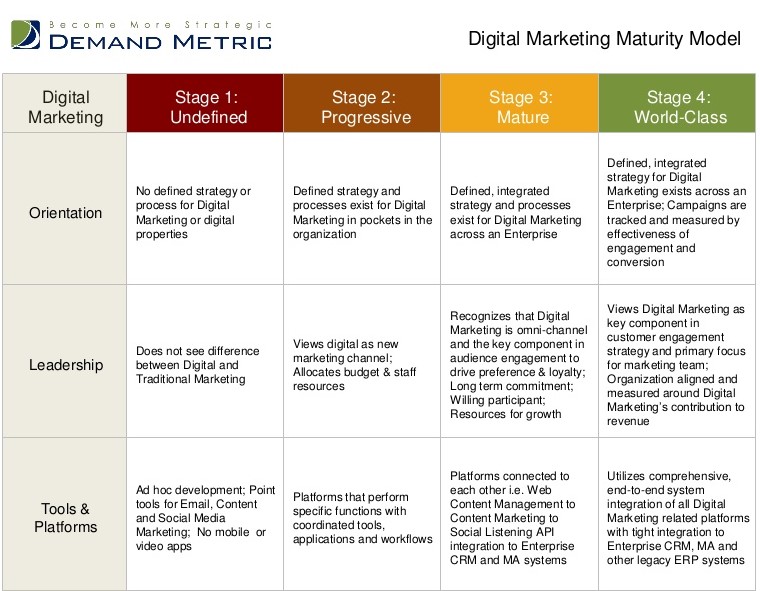
A prescriptive maturity model framework
The prescriptive maturity model goes further.
It attaches concrete advice to the possible maturity levels. Because each consultant has different strengths, specializations and focal points, their advice will differ. That’s why a prescriptive model is so useful to have: It leverages what makes your consultancy unique and gets you to stand out from your competitors.
5 reasons why a consultant should use a maturity model (framework)
There are many different types of maturity models that have been developed over the years. Each type will have a varying number of levels. It typically ranges from 3 – 10 maturity levels. Most maturity models are designed to be relevant for a specific industry or business area. Whatever the model or industry, there are a few key advantages attached to using a maturity model:
- More lead generation: You get to showcase a clear-cut vision and approach to the subject at hand. This is a great way to give prospects a taste of what you have to offer and of course the motivation to advance from one maturity level to the next with your guidance.
- Faster onboarding: Thanks to the predefined model, the process of evaluating a client’s condition is streamlined and more importantly, you have the chance to predefine offered services based on the maturity level of a client.
- Higher efficiency: The structured approach of a maturity model allows you to focus on the most critical areas for development. You don’t have to reinvent the wheel for each client.
- Stronger accuracy: Because you are applying the same evaluation criteria for each client, using the maturity model, you continuously develop useful benchmarks. You have a real-time view on industry standards and therefore evaluate very consistently.
- Customization of services: By applying the appropriate maturity model to a company, you may discover that it has a low maturity level in one area and a high maturity level in another. With this information, you can tailor your service offering specifically to your client’s situation.
We’ll now go on to discuss two of the most commonly used maturity models: The Capability Maturity Model (CMM) and the Agile ISO Maturity Model (AIMM). It’s best practice for every consultant to create their own maturity model based on their unique expertise, and use these commonly used maturity models as inspiration.
2 broadly used maturity models
Capability maturity model
The Capability Maturity Model is the original maturity model that was developed by the US Department of Defense in the late 1980s. It was designed specifically to evaluate whether a company could effectively deliver on software development projects.
According to the CMMI Institute, there are over 8500 accredited users of this particular model. Although designed around software development, the CMM can actually be applied to a wide range of related areas.
The CMM proposes five levels of maturity:
- Level 1 – Initial: At this maturity level the software development process can be chaotic as requirements for the system as a whole are unclear or uncontrolled.
- Level 2 – Repeatable: At this stage the software standards such as cost estimation, schedule and functionality are defined enough to be repeatable but the process is still reactive.
- Level 3 – Defined: By this level processes are better tailored to the business which means that the product is more likely to meet all the requirements for its intended use.
- Level 4 – Managed: This level shows a high capability as the business manages project processes quantitatively with statistics.
- Level 5 – Optimized: This is the highest maturity level and indicates efficiency and that the company can focus on process improvements to meet its objectives.
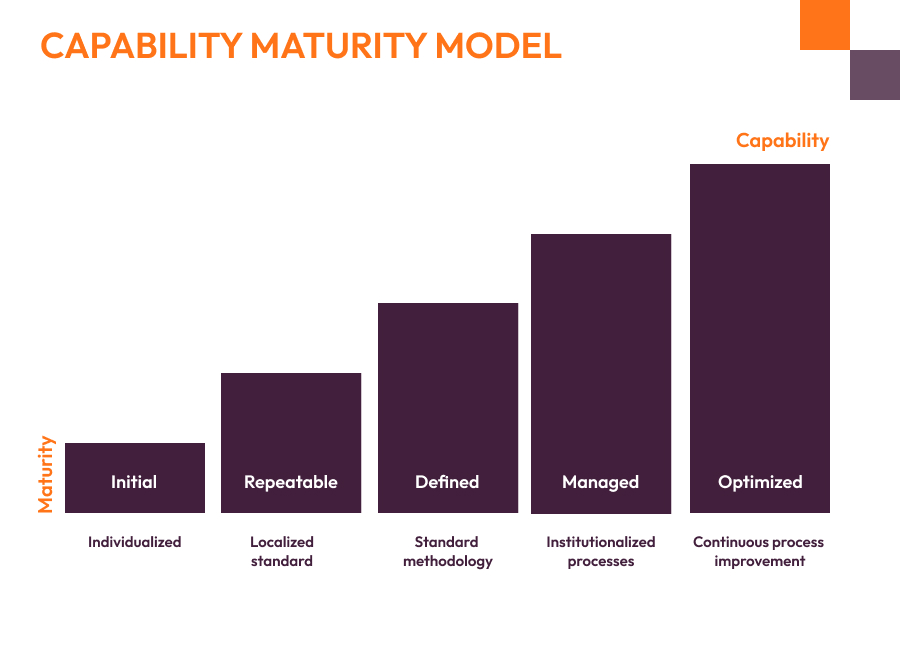
Agile ISO maturity model
Because the CMM was designed for software development companies, it is less suited for other industries or business areas. Therefore, the Agile ISO Maturity Model (AIMM) is a better option in the sense that it can help your clients better understand their current internal processes and how to improve them. The AIMM assessment looks at how a company can improving its agility level over time.
AIMM has a greater focus on business processes and can easily be applied across various industries.
There are three components to the AIMM:
- Agile – agile business processes get faster results as they are easy to adapt to changes and encourage collaboration across different departments within a business.
- ISO – the International Organization for Standardization provides an established framework of industry standards and best practices.
- Maturity Model – provides a way to qualitatively measure progress and turn it into quantitative metrics which helps a business reach its goals.
The idea is to use an AIMM assessment to help your clients measure their performance and use that information to create an agile system within the ISO framework for their industry.
The AIMM also consists of five stages:
- Level 1 – Documented Processes: The first level is reached when a company’s processes have been documented (in any form). This stage is characterized by awareness of all the processes throughout different areas of the business.
- Level 2 – Followed Processes: A company reaches the next level when they consistently put into action the processes they have documented. At this stage team members can follow the processes to the best standard each time and will easily be able to identify any flaws.
- Level 3 – Managed Processes: The third level is reached once a company starts to manage their documented and followed processes better by developing infrastructure around the processes. This infrastructure can take the form of process management software or a specialized process to team to collect and analyze data.
- Level 4 – Optimized Processes: The next level is all about using the data gathered through the infrastructure to optimize the current processes and improve output. At this point, the progress becomes about improvement which will continue over time as a business grows.
- Level 5 – Integrated Processes: The final stage revolves around creating new processes that complement the core processes and link different parts of a company. This could be done by developing processes for communication between leadership and staff or even processes to become a more sustainable or Eco-friendly business.
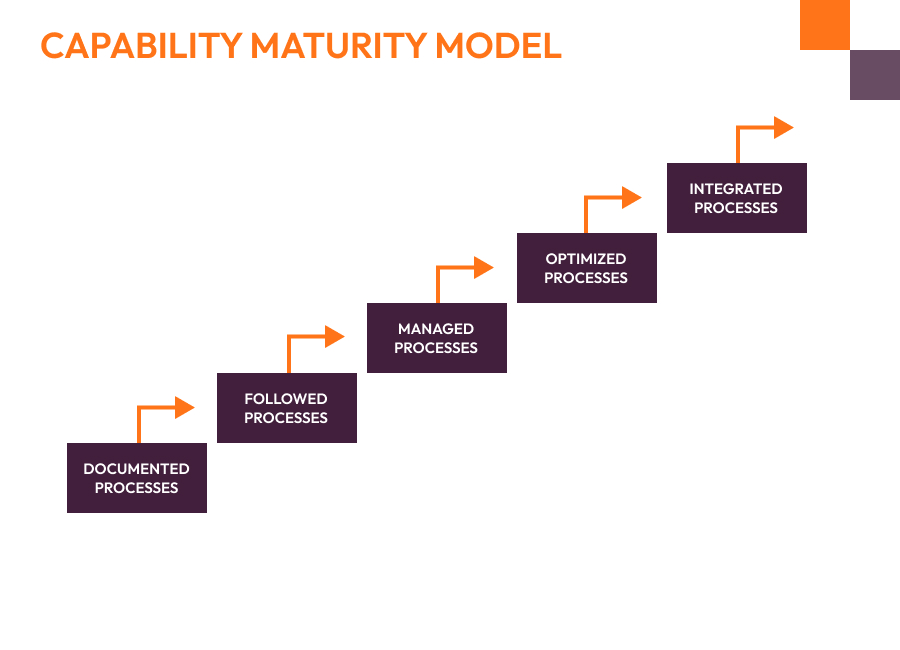
The goal of this model is not solely focused on the current performance, but rather on progress and finding ways to improve internal processes.
However, to ensure the best results for your clients, you should not use the CMM or the AIMM. These are simply examples of maturity models that have been created by others in the past to serve a specific purpose. Instead, develop your own maturity model that is specifically designed for your unique situation.
Why consultants should develop their own maturity models
Pointerpro’s very own Andres also discusses how to develop tailored advice through both a Capability Maturity Assessment and an Agile ISO Assessment in the video above.
The CMM or the AIMM are examples of great maturity models that have been created by others in the past to serve a specific purpose. If you want to stand out as a consultant, iwe encourage you to develop your own maturity model that is specifically designed for your unique situation.
Once you have a model, you can turn it into a digital assessment to feature online. It’s a great way to give prospects a taste of your expertise. In other words, it’s a great way to generate new leads. We discuss this in greater detail in our article on online consulting strategies.
How to create your own maturity model (and assessment)
Note: the following is a concise summary.
We’ve also dedicated an entire article as a guide to how to develop a sophisticated, custom maturity model.
So, in short: The first step in the process is to design and create a maturity model that’s applicable for your domain of specialization. You need split this domain into subdomains and determine the parameters that will be used to measure the level of maturity in each subdomain.
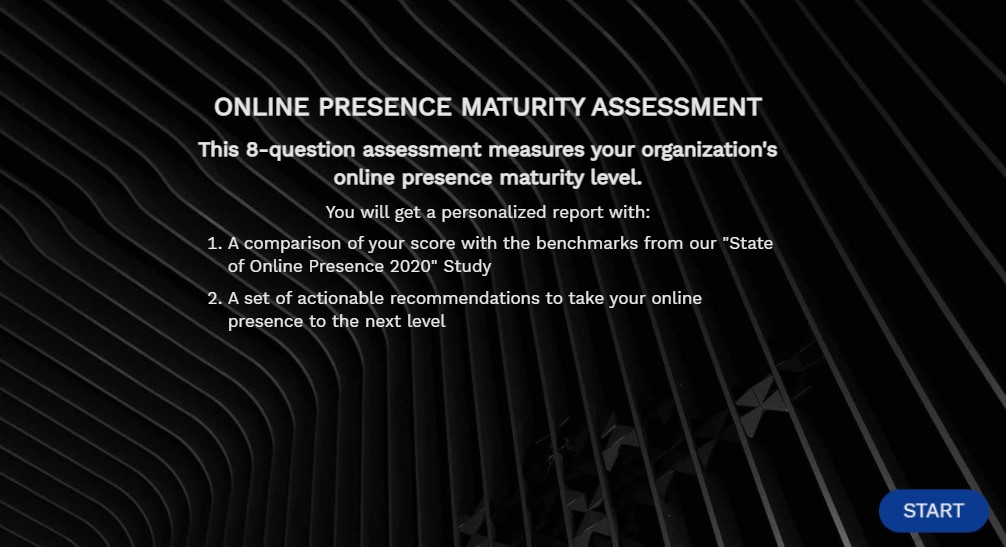
A simple Online Presence Maturity Model for example, will consist of a number of subdomains along with parameters that evaluate performance using three maturity levels :
Subdomain 1: Blogging
- Level 1: No blog
- Level 2: There is a blog, with less than two articles per month published
- Level 3: There is a blog, with more than two articles per month published
Subdomain 2: LinkedIn Presence
- Level 1: The company nor its CEO is present on LinkedIn
- Level 2: The company or its CEO is present on LinkedIn and typically posts less than once per month
- Level 3: The company or its CEO is present on LinkedIn and typically posts more than once per month
And so on…
In addition to this, you can perform (or use existing) research to discover the industry benchmarks (average performance levels) in each of the subdomains.
After having collected this information from a customer, a consultant will typically summarize their findings in a nicely looking report, indicating the client’s performance levels vs. the benchmarks along with personalized recommendations on how to improve in the different subdomains.
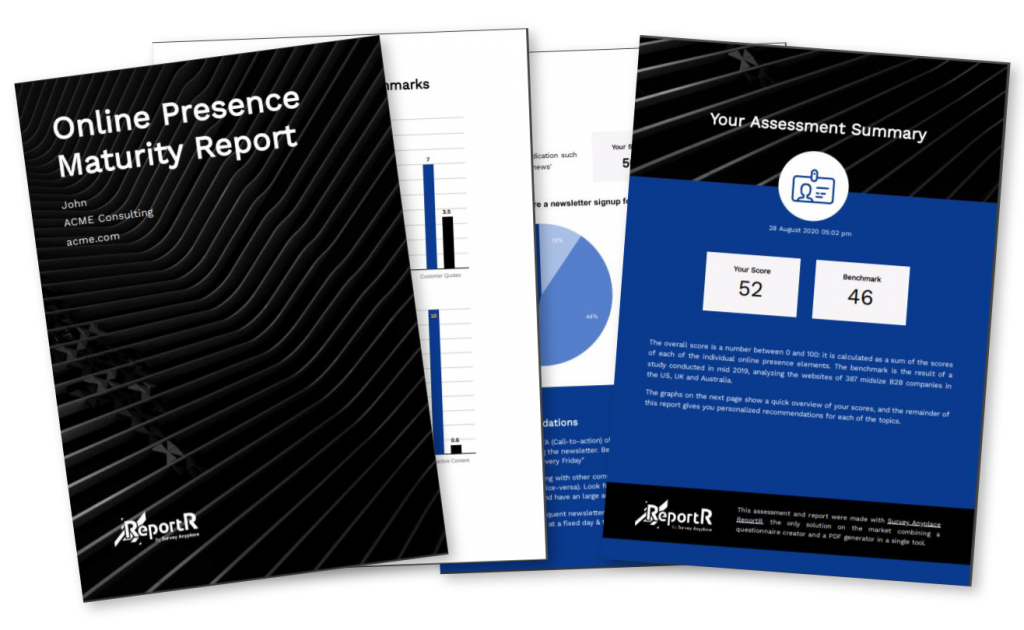
The first step in the process is to design and create a maturity model that’s applicable for your domain of specialization. You need split this domain into subdomains and determine the parameters that will be used to measure the level of maturity in each subdomain.
From maturity model to effective maturity assessment
Maturity assessment tools, like Pointerpro, automate the process of collecting information and generating the personalized reports. In other words, they help you turn your maturity model into a hands-on assessment for clients or prospects to take. In other words, the perfect self-service tool.
You present this assessment to your (potential) clients. They then answer the questions you’ve defined to designate their maturity level. Once completed, a PDF report will automatically be generated based on their answers. This will be auto-sent to your client as is along with an explanation of how you can help them based on the results of their assessment.
The content of the report will depend on the purpose of the maturity assessment but will generally provide information on:
- Required improvements.
- Level of functioning compared to the industry standard.
- Activities or tasks that will lead to improvement.
- How your services can assist their business: his can include a CTA (Call-To-Action) to book an appointment with someone of your team.
The automated nature of maturity assessments means that you can provide extremely valuable transactional advice to potential clients at scale. Not only do they get detailed insights into their business via text, statistics, charts and graphs on their report, but also your guidance on how to proceed. With continually fine-tuning, these assessments will help you grow your business.
Maturity assessments provide you with a genius solution for building the ‘know, like, trust’ factor as a consultant.
Example of a well-developed maturity assessment
Axway seamlessly integrated their Digital Maturity Assessment into a landing page on their website. By providing their visitors with straightforward information about the steps involved and an example of what to expect from the assessment on this landing page, they come across as transparent and therefore, trustworthy.

As a result, a higher percentage of visitors take their assessment which helps them to generate more leads. A landing page and assessment offers consultants a way to effectively automate their lead generation process in a way that results in more conversions.
Want another example? Discover what another one of our customers, Elements.cloud, was able to pull off.
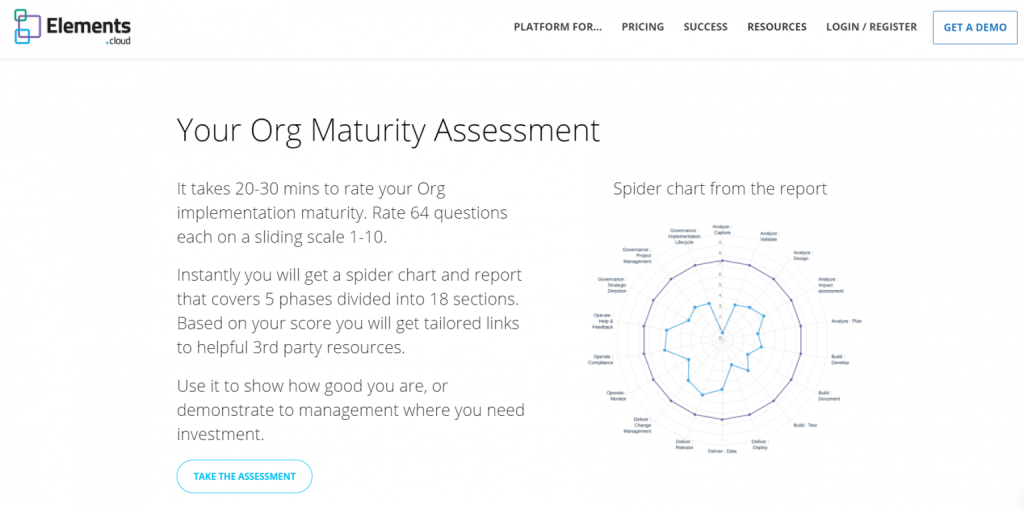
Get started
Here’s a short video introduction on getting started with a maturity model in less than two minutes.
You too can unlock the power of maturity models by creating your own custom maturity assessment through Pointerpro today. Templates are provided to ensure that designing your maturity assessment is simple. Your clients are given immediate yet highly personalized feedback through fully branded PDF reports which can be downloaded instantly.
The easy-to-use Pointerpro platform provides you with all the tools you need to diagnose your client’s performance levels and provide automated advice on how to improve.
One of the fundamental tools in Pointerpro to get there? Custom scoring and formulas. These allow you to quantify respondent answers and attribute the right maturity level to them. Below is a help guide video for Pointerpro users who want to use sophisticated scoring in their Pointerpro-built assessments.



